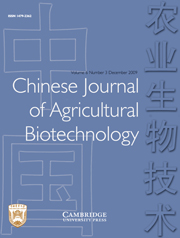Article contents
Development of specific SSR marker for Ee genome of Thinopyrum spp. using wheat microsatellites
Published online by Cambridge University Press: 12 February 2007
Abstract
Wheatgrass, Thinopyrum Löve (Elytrigia Nevski), is one of the most important alien resources for wheat improvement. To determine the transferability of wheat microsatellite primers to Thinopyrum spp., 40 wheat microsatellite primer pairs were selected to perform PCR analysis on 17 accessions of Thinopyrum spp. and two common wheat (Triticum aestivum) cultivars. Among the 40 primer pairs used, 25 pairs could produce PCR products on all or most of the alien species. Moreover, all of these 25 primer pairs, except Xgwm325, showed polymorphism in the Thinopyrum accessions. In total, 108 alleles were detected by the 25 primer pairs. The number of alleles per primer pair varied from 1 to 8, with an average of 4.3 alleles per primer. Although primer Xgwm325 did not detect polymorphic alleles in Thinopyrum spp., it could be used as a specific SSR marker for them. It amplified four specific DNA fragments in Thinopyrum spp. of length approximately 1400, 440, 120 and 100 bp. To verify the validity of these molecular markers, a further PCR programme with primer Xgwm325 was conducted on a full set of seven wheat–Thinopyrum elongatum disomic addition lines and 15 disomic substitution lines. This showed that only the 100-bp fragment appeared in all materials possessing the alien chromosome, indicating that it was a molecular marker for the entire genome of Th. elongatum, although primer Xgwm325 was specific for chromosome 6D in wheat.
Keywords
Information
- Type
- Research Article
- Information
- Copyright
- Copyright © China Agricultural University and Cambridge University Press 2004
References
- 2
- Cited by

